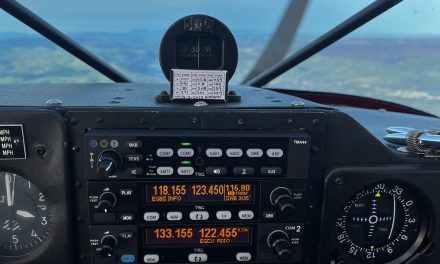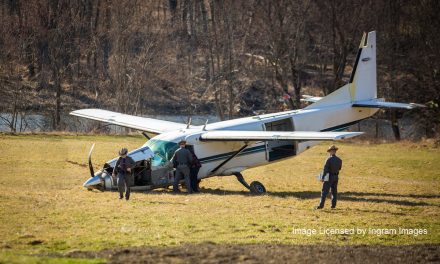Just Plane Propaganda
A Pilot’s Response to the Mainstream Media’s Latest Attack on General Aviation
By Jim Cavanagh
In a fine example of history repeating itself, General Aviation has once again taken it on the chin from the popular media. In June, USA Today ran a three-part story on the dangers of General Aviation. The three parts, titled: “Death by Birdstrike,” “Figuring the Value of a Human Life,” and, “A ‘New’ Helicopter, Designed in 1956” certainly screamed out for readers. These three parts were later promoted within USA Today pages and on the website as, respectively, “Unfit for Flight,” “Unchecked Carnage,” and “How much is a Human Life Worth?” Compelling would be one word to use, but in the old days it was called yellow journalism.
The series focused on the deaths attributed to helicopters (in particular post-crash fires), the Mitsubishi MU-2, and the Cessna Caravan, whose flight in icing conditions caused a number of deaths from 1997 until 2002. These three subjects were supported by cool graphs and statistics, so they have to be true, right? Well, here’s the thing about statistics: statistics don’t lie…but then, statistics aren’t a story.
Statistics are the result of a story, and in themselves mean little—other than, perhaps, establishing a trend. A trend, however, needs to be a long-term accumulation of numbers that are relevant to a preordained topic, and the actual trend needs to be defined in specific terms and attributed to specific situations rather than a general mixing of apples and oranges to establish a number. Indicting all of General Aviation because of helicopter accidents/deaths, MU-2 accidents/deaths, and Cessna Caravan accidents/deaths, is like saying all fireworks are dangerous if a single cherry bomb goes off in a kids hand or a bottle rocket ignites a field of dried grass. As Benjamin Disraeli said, “There are three kinds of lies: lies, damn lies, and statistics!”
The authors of the USA Today series, of which there were many, obviously had an agenda. We aviation pundits continue to counter this mean spirited, ill-conceived publicity in many aviation media, but it is fruitless. We are preaching to the choir. Nothing gets back to the authors of the misinformation. The writers need to be taken to task; the agenda needs to be vetted.
Who conceives this kind of story? Who outlined the path to creating the pieces? Who recruited writers who would follow a narrow, calculated outline of statistics and accumulate data to substantiate the thesis of these three articles? USA Today is in general the culprit, but someone on the loop has an agenda and, hell, it could be marketing and sales!
The reporters, and there were a slew of them, interviewed some pretty important people with great credentials and lots of letters after their name. Few, if any were pilots. Most were from academia or the government. Even fewer were what one would call peers in this adjudication of all of General Aviation. Why do reporters not talk to pilots? Why do they not interview people who know and understand aviation?
The best answer is that there is a risk to interviewing someone who will not say anything to support treatise of your work. Think about it. When a writer, like me or anyone else, has a story, we develop a slant—a direction we want the piece to go. At the end of that slant is a result that we shoot for. This is a predetermined result, a planned (maybe subliminally) conclusion to which we want people to ponder. If I was to write a story about killing baby seals, I would not interview a guy who runs a baby seal restaurant. DUH! Nuff said.
Now we have to wonder why an editorial board, or whoever gave the go-ahead to the USA Today series, would want to scare the American public. What has General Aviation done to these people to make them so dark and negative? There can only be a handful of possible answers:
First, perhaps aviation might truly be dangerous, and everybody in the industry knows it—except for the pilots. As long as they can keep selling airplanes and fuel and aviation stuff, the mortality rate of pilots and passengers is only important or relevant as a reduction of potential customers.
Secondly, aircraft manufacturers, working in collusion with the government, want to kill as many people as they can while laughing at the continued sales of their “death machines!”
These two explanations don’t seem likely, but they hold about as much truth as the USA Today articles. So now let’s take a look at a couple more realistic scenarios.
Stories develop because someone heard a statistic (remember those?) that caught in his or her intellect. That an activity can be so dangerous yet so prolific, begs the question of some collusion between the manufacturers and the government. Ah, a nice, juicy conspiracy!
Conspiracies exist because people cannot understand something and they begin extrapolating and conjecturing to come up with an answer they personally can understand. When we can’t, we try again with new or different facts. We fear the unknown. We are suspicious of things that do not jell with our understandings. Writers and editors are not immune to this. Journalists, particularly these days where competition is keen and air time or print space is precious, need to make quick impressions, hopefully with stories that have “juice,” and the propensity is for these journalists to be looking for some item that can be played into a story. And remember, the tendency is to accept and embrace information that supports your thesis and reject or ignore information that does not. At this point, objectivity and fairness is thrown out the window!
Another scenario is that perceived danger is one of the bastions of our survival instincts. The psychologist, Abraham Maslow, came up with the first list of “psychological needs.” Both he and a number of people have tweaked this list since its inception, but the premise remains the same: Survival is need number one, and includes needs for food, shelter and safety. We need to feel safe, whether we are aware of it or not, and being made to feel unsafe or vulnerable is an important part of the USA Today, nay, the news media in general. Being threatened makes us aware. Being aware makes us interested. We need more information, so we buy more papers.
And so, it has come all the way around to the manipulation of our personal need for safety by marketing teams. The old term, “negative sells” is again at work. Happy, fat puppies don’t sell nearly the number of newspapers as dismemberment murders. It is a simple fact of life. It also makes me think that news, however researched and validated, seems to have an element of non-reality; that it’s just a story and of no consequence. The reality trigger doesn’t kick in. News remains abstract until we can associate with it.
Years ago I wrote a piece that included interviews with local media. I found out that the perception of news professionals (back then) is that aviation is its own worst enemy. That it is, indeed, so safe, that anything at all involving an airplane is a shock to the general consciousness. A story of an airplane crashing is one thing, but when embellished by the proximity of a school yard, or any emotionally charged back story, it becomes compelling. When you factor in the ignorance of most journalists and the natural tendencies to be suspicious or intimidated by what they don’t understand, you get a cadre of professional wordsmiths out to save us from the bad boogers in aviation! Today, this tendency is rife in aviation since there is an actual perception by the media and the general public that flying is truly dangerous.
For decades tragic airshow mishaps, disaster movies, and accident reports, have conditioned us to view flying as a dangerous activity similar to an extreme sport and pursued by rich, bored, or psychotic people looking to prove themselves. If it were not for the allure of spontaneous explosions or carnage, the air races of old would never have created mass interest in aviation, and we probably wouldn’t have bull riding or NASCAR either. Everyone defaults to being suspicious of things unknown.
What has added substance to the reports is that the FAA has, for decades, defaulted to Pilot Error as the primary reason for airplane accidents. Initially, this seems to put the onus on the pilot; however, the USA Today hit squad determined that this was yet another facet of the conspiracy between government and manufacturers to take the blame off of the manufacturers. An ironic twist—but not necessarily far off the mark. Much of the responsibility for lagging safety is shared by the FAA and the American Trial Lawyers Association. The FAA makes it so difficult to certify new technology that it is amazing a new technology or safety feature ever gets integrated into an airplane.
In the old days, the FAA would study, test and manage an application for a change to an airplane. Inspectors would be assigned a project and their jobs would be gauged by the amount of work they accomplished. In the ‘70s, with the first couple of generations of FAA middle management retiring, there arose this system of using DERs and DARs to actually go out into the field and supervise a project and sign off on it. All of a sudden, retired FAA guys were making $300-400/hour or more doing what they had done within the agency for paupers pay. A retiree with any credentials at all was guaranteed not only his pension, but an income at attorney rates! Applications for STCs started requiring a number of different specialists to sign off on different aspects of a STC or a PMA. The result was no impetus within the FAA to get involved until the DER/DAR was finished, and there was no incentive for these latter to speed up the process. The result was that any modifications, including safety related mods, was either delayed or scuttled by the expense or the frustration.
The attorneys had their own effect on aviation safety. Now get this: Unison, long-time makers of Slick Magnetos, had an electronic ignition system that they would not introduce because their attorneys suggested that it would be a tacit admission that the older magnetos were unsafe and required replacement. This was told to me by their sales manager. I’ve heard the same story from other manufacturers. When reality is turned around like this and the concept is embraced by jurisprudence, what hope is there of any new technologies emerging?
As I said, neither this piece nor any others like it will make any significant difference in ameliorating the media situation. Traditionally, pilots have never banded together with any cohesiveness to create a unified positive “public relations” effort to explain aviation to the masses. Even when the alphabet groups try to do it, it becomes politically polarized into how much they are doing for you in exchange for your dues. Put simply, the aviation community is too large for cohesiveness, yet too small to have a real impact on the national consciousness.
There are, however, a number of changes that can be made by the FAA to help aviation prosper, grow, and achieve higher levels of safety:
- The FAA could actively promote the realization that aviation is not magic, and that pilots do not actually want to harm themselves or others.
- They could initiate a “fast track” method of approving aircraft mods that could improve safety and benefit everyone.
- FAA involvement and enthusiasm could make aviation more accessible to new and existing pilots.
- And, would it be too much to ask that the FAA actually step up and come to bat for us in light of negative, misleading press like the USA Today series?
We who fly today are so lucky to be able to continue enjoying our passion. Though I’m optimistic about the day-to-day aspect of flying, I’m pessimistic about the future of aviation.
We’re experiencing a lot of changes; and, unfortunately, it appears that our progeny will not experience the same brand of aviation we’ve enjoyed—that’s if they can enjoy it at all. I don’t just mean overcoming the ever-growing expense, but rather overcoming the danger of further damaging the perception that flying is not only a safe and enjoyable method of transportation, but a lifestyle based on individuality and independence.






